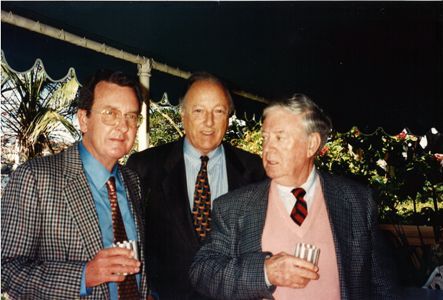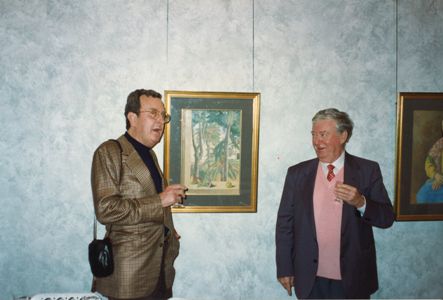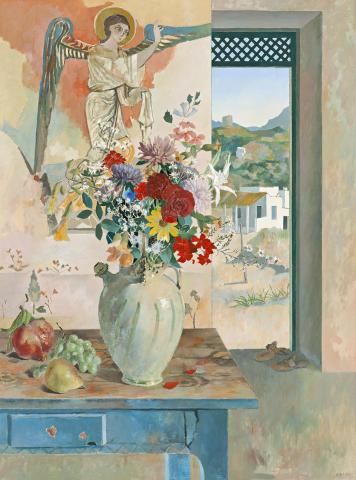STILL LIFE WITH ANGEL FRESCO, 1972
JUSTIN O'BRIEN
oil on composition board
73.5 x 54.5 cm
signed lower right: O’BRIEN
bears inscription verso: 18
Macquarie Galleries, Sydney
The Estate of the late James O. Fairfax AC, New South Wales, acquired from the above in 1972
Recent Works by Justin O’Brien, Macquarie Galleries, Sydney, 11 – 23 October 1972, cat. 3
Cranbrook School Art Exhibition, Cranbrook School, Sydney, 14 – 17 October 1976, cat. 83
Merioola and After, S. H. Ervin Gallery, Sydney, 12 July – 17 August 1986; Newcastle Region Art Gallery, Newcastle, 28 August – 5 October 1986, and Geelong Art Gallery, Geelong, 16 October – 16 November 1986, cat. 77
Justin O’Brien: A Birthday Tribute, National Gallery of Victoria, Melbourne, 31 July – 13 September 1987, cat. 15 (label attached verso)
Justin O’Brien, The Sacred Music of Colour, Art Gallery of New South Wales, Sydney, 18 December 2010 – 27 February 2011, cat. 71
Margaret Olley – Painter, Peer, Mentor, Muse, S. H. Ervin Gallery, Sydney, 7 January – 26 March 2017 (illus. in exhibition catalogue, pp. 72 – 73)
Bradley, A., The Art of Justin O’Brien, The Craftsman’s Press, Sydney, 1982, pl. 19, pp. 24, 66, 67 (illus.), 105
Grishin, S., ‘An Australian Painter in Rome: Justin O’Brien’, Art and Australia, Sam Ure Smith at the Fine Arts Press, Sydney, vol. 21, no. 4, Winter 1984, pp. 493, 494 (illus.)
France, C., Merioola and After, National Trust, Sydney, 1986, p. 27
France, C., Justin O’Brien: Image and Icon, Craftsman House, Sydney, 1987, pl.18, pp. 25, 68, 69 (illus. and front cover) 126
France, C., Justin O’Brien: Image and Icon, Craftsman House, Sydney, revised edition, 1997, pl. 18, pp. 25, 76, 77 (illus.), 168
Pearce, B. and Wilson, N., Justin O’Brien. The Sacred Music of Colour, exhibition catalogue, Art Gallery of New South Wales, Sydney, 2010, pl. 71, pp. 111, 114 (illus.), 160
From the vantage point of his fisherman’s cottage by the sea, Justin O’Brien delighted in painting the changing effects of light and colour on the simplest of objects in his Grecian home. Still Life with Angel Fresco, 1972 shimmers with heat and expectant stillness. The soft velvety finish of O’Brien’s oil paint carefully translates the surface textures of each object in his field of vision, from the delicate petals of chrysanthemums in a bouquet, to the skins of green grapes, the worn and cracked leather of sandals in the doorway, and the crumbling plastered surface of the fresco. Every object presented here is imbued with timeless simplicity, of ancient modes of interaction with the landscape, unchanged for millennia – yet interpreted by O’Brien in a blaze of modernist colour and flat rendition of form.
Still Life with Angel Fresco, purchased directly by James Fairfax from O’Brien’s exhibition at Sydney’s Macquarie Galleries in 1972, was exhibited along with Still Life Against a Landscape – a smaller work, a variation on the same theme. Still Life with Angel Fresco depicts the same view of the wooden table, identical down to the precise recreation of the arrangement of fruit and flowers, but placed against an open doorway and frescoed wall instead of a window. Here, the eponymous angel gestures towards an enticing sliver of landscape visible through the doorway, blessing the view with a raised hand. The rocky, arid landscape beyond was the artist’s own paradis terrestre, a place where a simple existence could reveal hidden spiritual forces.
In 1967, Justin O’Brien resigned from his teaching position at Cranbrook School and left Sydney, returning to the Greek island of Skyros where he had holidayed some years previously. A decade later, he explained to Christine France, who was writing a monograph on his work, that despite much criticism from his peers he found his work to be especially stimulated by the peaceful beauty of the Aegean.1 He wrote to his friend Martin Sharp in London, expressing a desire to ‘get away from this rat race and bury my Irish mug in some Aegean sand. If this is living I’d rather be dead!’.2 In the tense socio-political context of the late 1960s, O’Brien was not alone in seeking an unspoiled natural environment, away from the threat of an impending war in Vietnam, and the claustrophobia of exponential urban sprawl and capitalist consumption.
Still Life with Angel Fresco is a joyful expression of O’Brien’s visual awareness and appreciation of his immediate environment, with all the gaiety and verve that modernism allowed. Having shed the static and heavy religious symbolism of his earlier works, O’Brien’s still lives of the 1970s and 1980s exude a joyous luxuriance – an almost baroque exaltation of life’s blessings and fruits. O’Brien’s early religious works bore much in common with early Sienese and Byzantine styles of representation, and in this respect, Sasha Grishin identifies the fresco in this picture as an ‘emotional counterfoil’, a lingering stylistic memento of earlier artistic endeavours.3
Justin O’Brien was a contemporary of James Fairfax, an artist-friend who benefited from his direct patronage and with whom the collector socialised. Fairfax purchased Still Life with Angel Fresco from its first exhibition at Macquarie Galleries, even before it had opened to the public, having enjoyed exclusive previews of exhibitions there from his early teenage years.
1. France, C., Justin O’Brien. Image and Icon, Craftsman House, Sydney, 1987, p. 24
2. Correspondence between Martin Sharp and Justin O’Brien, dated 19 Jan 1967, cited in Pearce, B. and Wilson, N., Justin O’Brien. The Sacred Music of Colour, Art Gallery of New South Wales, Sydney, 2010, p. 104
3. Grishin, S., ‘An Australian Painter in Rome: Justin O’Brien’, Art and Australia, Sam Ure Smith at the Fine Arts Press, Sydney, vol. 21, no. 4, Winter 1984, p. 493
LUCIE REEVES-SMITH
Sydney Gallery Manager
Deutscher and Hackett
21 - JAMES FAIRFAX, LESLIE WALFORD AND JUSTIN O’BRIEN.jpg

JAMES FAIRFAX, LESLIE WALFORD AND JUSTIN O’BRIEN
21 - JAMES FAIRFAX AND JUSTIN O’BRIEN AT AUSTRALIAN GALLERIES.jpg

JAMES FAIRFAX AND JUSTIN O’BRIEN AT AUSTRALIAN GALLERIES
